Petroglyphs & Ruins
Anthropological evidence indicates that human beings have lived in the Salt Lake area for about 12,000 years. The Ancestral Puebloans or Anasazi (a Navajo word for "the ancient ones") first appeared in approximately 1,000 BC. The Anasazi were a sedentary people with an agricultural culture subsisting on maize, beans & squash. They built masonry dwellings & apartment complexes tucked into cliff faces or on valley floors. They built pithouse granaries, made coiled & twined basketry, clay figurines & fine pottery. They prospered until 1200 - 1400 A.D. when climactic changes, crop failures & the intrusion of Numic peoples forced their migration southward where they reintegrated with the Pueblos of Arizona & New Mexico.
In Utah, the Numic peoples evolved into four distinct groups. The Sheshone occupied the northeast part of the state. The Kusiutta inhabited the western deserts. The Kusiutta lived in small nomadic family bands & constructed brush shelters called "wikiups." The Paiute lived in southwest Utah. All of these were successful hunter-gatherers with the Paiutes combining their hunter-gatherer subsistence system with some flood-plain gardening. The Paiutes were a peaceful people who suffered at the hands of their more agressive Ute neighbors. The Ute, for whom the state is named, occupied the central & eastern two thirds of the state. They were also hunter-gatherers who adopted the horse & buffalo culture of the Plains Indians.
By 1700 Navajos began to move into the San Juan River drainage area of Utah in search of pasture for their sheep & goats. They were highly successful hunter-gatherers who incorporated domestic livestock into their subsistance system. They lived in extended family units dwelling in "hogans" which some still use to this day. Navajos came under pressure from the raiding Utes in the 1720's - 1740's forcing many to retreat from Utah.
All of these people have thankfully left behind a museum of rock art or "petroglyphs" throughout the state. I have here a sampling of some of the more popular examples. Click on a picture to enlarge.

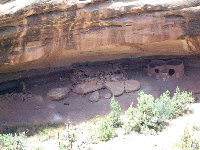
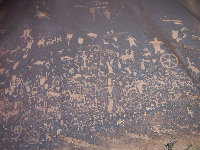
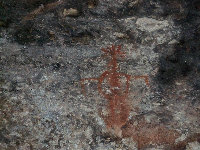

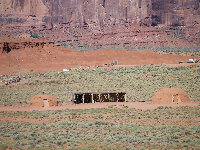
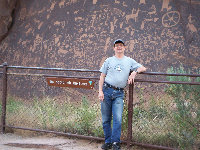
Granaries served as storage bins for corn, seeds or nuts. They were often well hidden, & sometimes located in almost inaccessible places.
Navajo Hogans
Me at Newspaper Rock
Newspaper Rock was carved by native americans during both prehistoric & historic times. The reason for the large number of carvings is unclear making the rock somewhat of a mystery.
The Anasazi Horsecollar Ruin earns its name from the shape of the doors to these granaries.
Ancestral Puebloan Petroglyph
Anasazi Petroglyph
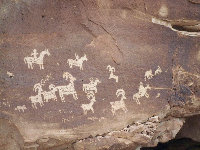
The stylized horse & rider surrounded by bighorn sheep & dog-loke creatures is typical of Ute rock art. These were carved between 1650 & 1850 A.D.







